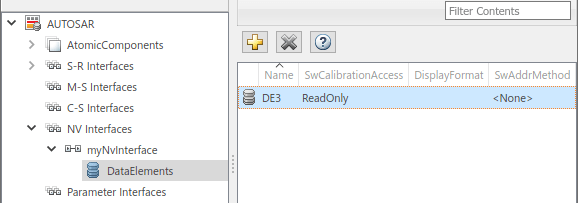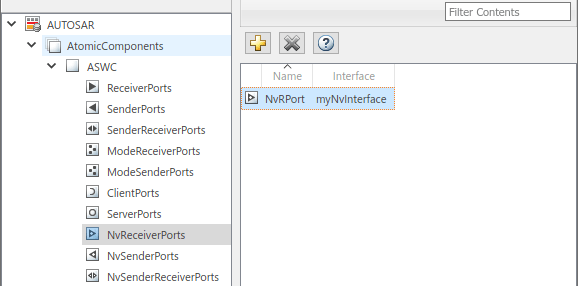Configure AUTOSAR Nonvolatile Data Communication
The AUTOSAR standard defines port-based nonvolatile (NV) data communication, in which an AUTOSAR software component reads and writes data to AUTOSAR NV components. To implement NV data communication, AUTOSAR software components define provide and require ports that send and receive NV data. For more information about modeling software component access to AUTOSAR NV memory, see Model AUTOSAR Nonvolatile Memory.
In Simulink®, you can create AUTOSAR NV interfaces and ports, and map Simulink inports and outports to AUTOSAR NV ports. You can model AUTOSAR NV ports with Simulink inports and outports, in the same manner described in Sender-Receiver Interface.
To create an NV data interface and ports in Simulink:
Add an AUTOSAR NV interface to the model. Open the AUTOSAR Dictionary and select NV Interfaces. Click the Add button
 . In the Add Interfaces dialog box, specify
the interface name and the number of associated NV data elements.
. In the Add Interfaces dialog box, specify
the interface name and the number of associated NV data elements.Select and expand the new NV interface. Select DataElements and modify the data element attributes.

Add AUTOSAR NV ports to the model. Expand AtomicComponents > ASWC, and use the NvReceiverPorts, NvSenderPorts, and NvSenderReceiverPorts views to add the required NV ports. For each NV port, select the NV interface you created.

Map Simulink inports and outports to the AUTOSAR NV ports you created. Open the Code Mappings editor. Select and use the Inports and Outports tabs to map the ports. For each inport or outport, select an AUTOSAR port, data element, and data access mode.

To programmatically configure AUTOSAR NV data communication elements, see Programmatically Configure AUTOSAR Nonvolatile Communication.